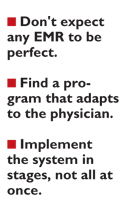Article
Technology Consult
Author(s):
Tips from an EMR pioneer

Since 1979, his office has gone through five EMR systems, and it's about to switch to a sixth later this year. His first EMR was rented from a billing service that housed the server offsite. By the mid-1980s, he was performing the kind of computer tricks that most doctors today only dream about-automatically generating a list of preventive care tests due for a particular patient before an office visit, for example, or receiving drug interaction alerts when a new medication was entered into the chart.
Park has not only used computer technology, but has also created it. He designed an EMR program for his practice and later marketed it to other doctors. He now presides over a fledgling company that builds interactive practice Web sites where patients-like his-can request an appointment or receive medical advice online.
You're buying an EMR, not marrying one. "Doctors tell me that they put off buying an EMR because they're afraid of making the wrong decision," says Park. "This stems from the assumption that they must find the perfect system. It doesn't exist, and never will. There are plenty of good systems, though, and they're all better than working with paper. So pick one and make it work.
"You're not necessarily making a lifelong decision. If your needs change, you can switch. It's never been hard for us to convert our data files from one EMR to another. And once you learn to use one EMR, learning the next system goes a lot faster."
Pick a system that gives doctors data entry choices. "Nearly all the failed EMR implementations I've seen have failed because physicians were slowed down by data entry. So find a program that adapts to the physician. If he wants to dictate, let him dictate. If he wants to type, let him type. A good program will give you choices.
"One problem I've found is that some programs insist on too much structured data. Every cough and heart murmur must be classified down to the nth degree. True, the result is a very rich database. You can search for all patients with coronary artery disease who initially presented with left shoulder pain, for instance. You can't easily extract that information from dictated notes. However, the data entry required for this is very tedious. So there's a trade-off between structured data and usability."
Go-slow works best. "I'm a proponent of incremental adoption, such as starting out with e-prescribing. Implementing every feature at once can tie doctors in knots and hurt productivity. Likewise, when you move up to documenting visits on the EMR, you might want a transition period in which you use the system for every third patient, and rely on paper charts for the others."
The financial case for EMRs is getting stronger. An EMR can trim your costs. Park sees the proof when he looks at the books for his group, which includes practices that don't have EMRs. "It costs us $59,000 a year less per doctor, on average, to operate a practice that's fully automated compared with one that uses paper charts," says Park.





